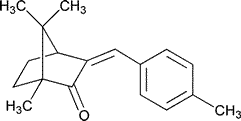Enzacamene
»Enzacamene contains not less than 98.0percent and not more than 102.0percent of C18H22O,calculated on the dried basis.
Packaging and storage—
Preserve in tight containers.
Identification—
A:
Infrared Absorption á197Kñ.
B:
Ultraviolet Absorption á197Uñ—
Solution:
10µg per mL.
Medium:
methanol.
Absorptivities at the wavelength of maximum absorbance,about 299nm,calculated on the dried basis,do not differ by more than 3.0%.
Loss on drying á731ñ—
Dry it in vacuum at 50 to constant weight:it loses not more than 0.2%of its weight.
to constant weight:it loses not more than 0.2%of its weight.
Related compounds—
Test solution—
Use the Assay preparation.
Chromatographic system—
Proceed as directed in the Assay.
Procedure—
Separately inject equal volumes (about 1µL)of the Standard solutionand the Test solutioninto the chromatograph,record the chromatograms,and measure the responses for the major peaks.Calculate the percentage of each impurity in the portion of Enzacamene taken by the formula:
100(ri/rS),
in which riis the peak response for each impurity obtained from the Test solution;and rSis the peak response of enzacamene obtained from the Standard solution:not more than 0.02%of camphor is found;not more than 0.1%of any other individual impurity is found;and not more than 0.5%of total impurities is found.
Assay—
Standard preparation—
Dissolve accurately weighed quantities of camphor and USP Enzacamene RSin dichloromethane,and dilute quantitatively,and stepwise if necessary,with dichloromethane to obtain a solution having a known concentration of about 250µg of each per mL.
Assay preparation—
Transfer about 25mg of Enzacamene,accurately weighed,to a 100-mLvolumetric flask,and dissolve in and dilute with dichloromethane to volume.
Chromatographic system (see Chromatography á621ñ)—
The gas chromatograph is equipped with a flame-ionization detector and a 0.32-mm ×30-m fused-silica capillary column coated with a 0.25-µm layer of phase G1.The carrier gas is helium flowing at a rate of about 1.2mLper minute.The chromatograph is programmed as follows.Initially the temperature of the column is equilibrated at 100 ,then 5minutes after injection the temperature is increased at a rate of 10
,then 5minutes after injection the temperature is increased at a rate of 10 per minute to 230
per minute to 230 ,and maintained at 230
,and maintained at 230 for 10minutes.The temperature is then increased at a rate of 10
for 10minutes.The temperature is then increased at a rate of 10 per minute to 300
per minute to 300 ,and maintained at 300
,and maintained at 300 until the end of the procedure.The injection port temperature is maintained at 295
until the end of the procedure.The injection port temperature is maintained at 295 ,and the detector is maintained at 305
,and the detector is maintained at 305 .Chromatograph the Standard preparation,and record the peak responses as directed for Procedure:the relative retention times are about 0.2for camphor and 1.0for enzacamene;the tailing factor is not more than 1.0;and the relative standard deviation for replicate injections is not more than 2.0%.
.Chromatograph the Standard preparation,and record the peak responses as directed for Procedure:the relative retention times are about 0.2for camphor and 1.0for enzacamene;the tailing factor is not more than 1.0;and the relative standard deviation for replicate injections is not more than 2.0%.
Procedure—
Separately inject equal volumes (about 1µL)of the Standard preparationand the Assay preparationinto the chromatograph,record the chromatograms,and measure the responses for the major peaks.Calculate the quantity,in mg,of C18H22Oin the portion of Enzacamene taken by the formula:
100C(rU/rS),
in which Cis the concentration,in mg per mL,of USP Enzacamene RSin the Standard preparation;and rUand rSare the peak responses obtained from the Assay preparationand the Standard preparation,respectively.
Auxiliary Information—
Staff Liaison:Lawrence Evans,III,Ph.D.,Scientist
Expert Committee:(EMC)Excipients:Monograph Content
USP28–NF23Page 1255
Phone Number:1-301-816-8389
